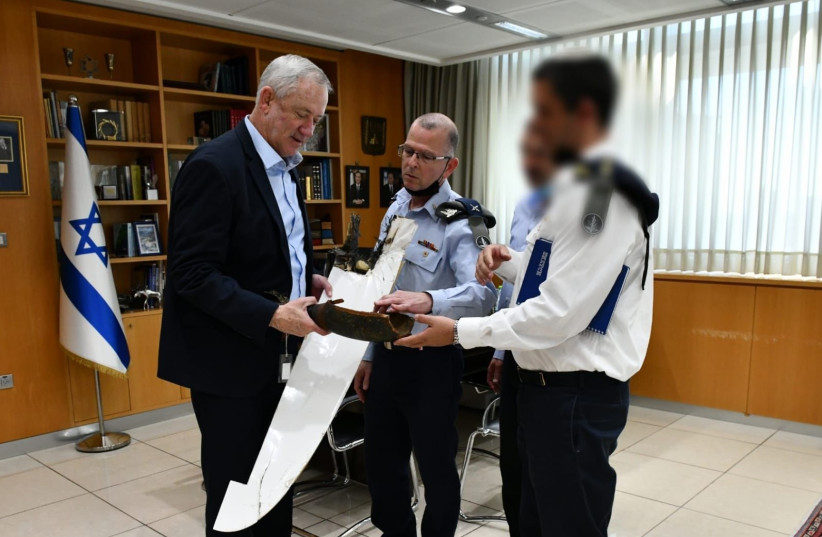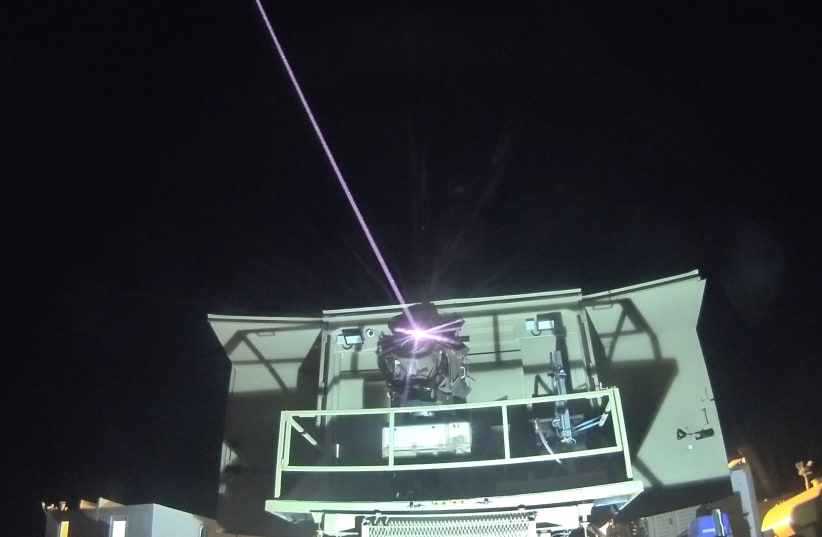Israel has taken a significant step toward achieving the operational capability of its ground-breaking laser system by carrying out a series of experiments, downing a variety of aerial threats at “challenging ranges,” the Defense Ministry announced Thursday.
The experiments, that were carried out in Israel’s South by the Defense Ministry’s Directorate of Research and Development (DDR&D, or MAFAT in Hebrew) and Rafael Advanced Defense Systems, saw the laser system known as “Iron Beam” successfully intercept a number of aerial targets including unmanned aerial vehicles, mortars, rockets and anti-tank missiles in various scenarios.
“This is a historical moment for weapons systems. For the first time, an energy-based weapons system actually works. I am not talking about ideas, but a system that works,” said Brig.-Gen. Yaniv Rotem, head of Military R&D in the Defense Ministry.
“Our mission was clear: to show that it works before the Passover holiday with all the criteria that we set,” said Rotem, adding that the series of experiments have allowed Israel to enter a “whole new era.”
“No one in the world has shown such capabilities. The State of Israel is the first to carry out a live firing attempt. We are in an age of new types of weapons – energy-based weapons. We are there,” he said.


Defense Minister Benny Gantz said that Israel has become one of the first countries to succeed in developing powerful laser technology at operational standards that can carry out interceptions in operational scenarios.
“Energy-based weapons with a powerful laser is, in my opinion, a very significant game-changer,” Gantz said, adding that the system “will contribute to the denial of critical enemy capabilities in all arenas.”
While Gantz said that it will still take time before it is fully operational, “for the first time ever a powerful laser system has intercepted distant targets. This achievement is because of Israeli innovation, the defense establishment, and the industries that have come together to provide an umbrella of security for the citizens of Israel.”
Calling it “first-rate breakthrough technology,” Gantz said the system will not only provide the IDF with great operational capabilities but it will give the government flexibility and the ability to breathe during wartime.
In March, Gantz approved the allocation of hundreds of millions of shekels to develop and produce a high-powered laser system. The Defense Ministry signed an agreement with Rafael Advanced Defense Systems to develop the system, which will be integrated into Israel’s multi-tier air defense to be used alongside the Iron Dome.
“The cooperation between Rafael and the Defense Ministry [research team] has led to a technological breakthrough and the completion of a significant milestone, one that will allow us to reach initial operational capability in a short time,” said Rafael CEO Yoav Har-Even.
Rotem told reporters that they were able to intercept a variety of aerial threats “at challenges ranges” for the first time. According to him, the ground system will be able to destroy targets at a range of eight to 10 kilometers (five to six miles) with a laser that goes beyond 100 kilowatts.


“The use of a laser system is an equality breaker and the technology is simple and proves economically viable,” he said.
According to Rotem, simulations were able to show that had the system been operational during Operation Guardian of the Walls “we would have saved hundreds of Iron Dome Tamir missile interceptors.”
More than 4,000 rockets and mortars were fired toward Israel during the 11-days of fighting between terrorist groups in the coastal enclave and the IDF. Each interceptor missile costs tens of thousands of dollars.
“We are embarking on a project to complete the initial development of the project, and the system will be operational and installed across the country within the next decade,” he said, adding that while the system is to be first deployed in southern Israel by the Gaza Strip, the defense establishment is always looking toward threats from the northern front.
Israel’s comprehensive protective umbrella that counters the growing missile threats includes the Iron Dome designed to shoot down short-range rockets; the Arrow (Arrow-2 and Arrow-3) system, which intercepts ballistic missiles outside of the Earth’s atmosphere; and David’s Sling missile defense system, which is designed to intercept tactical ballistic missiles, medium- to long-range rockets, as well as cruise missiles fired at ranges between 40 to 300 km. (25-186 miles).
However, these systems are expensive, and the laser system costs only a few dollars per pulse. The system will be used alongside the Iron Dome to intercept aerial threats.
According to the defense minister, the system is “effective, accurate and easy-to-operate” and is significantly cheaper than any other aerial defense system.
MAFAT head Brig.-Gen. (Res.) Dr. Danny Gold said that the technological breakthrough “has been proven as the operational requirement for a laser system that will form an integral part of the multi-layer defense system for the State of Israel is intensifying.”
In addition to the arsenals belonging to terrorist groups in the Strip, Israel considers Iran’s nuclear program the number-one concern. The IDF has admitted that Iran’s conventional missile threat is a major worry for Israel which, despite its multi-layered air defenses, may not be able to contend with intensive missile barrages fired by Iran and its proxy groups like Hezbollah in Lebanon or Shi’ite militias in Iraq.
The Defense Ministry will continue to improve the system and develop the airborne high-powered laser system with Elbit Systems that will be installed on planes and drones as well as a laser system that will be mobile for maneuvering ground forces.
The method of airborne interception, using a powerful laser, has many advantages, including a low cost per interception, the ability to effectively intercept long-range threats at high altitudes regardless of weather conditions, and the ability to defend vast areas.
